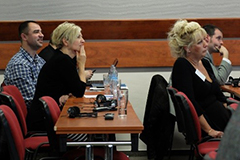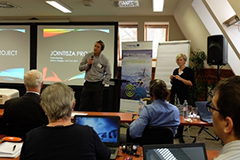JOINTISZA - Shared Vision Planning approach applied in Tisza River Basin
05-11-2018
Source: Global Water Partnership Central and Eastern Europe Website
The uneven distribution and quality of water resources in the Tisza River Basin brings challenges on how to elaborate the Programme of Measures as required by the EU Water Framework Directive. The team of 43 experts is currently working on the update of River Basin Management Plan under the Interreg project JOINTISZA.
By bringing together authorities and experts from five European countries (Hungary, Romania, Serbia, Slovakia and Ukraine), the JOINTISZA project aims to enhance the status of waters of the Tisza River Basin. The project focuses on interactions of two key aspects of water management — river basin management (RBM) and flood protection.



An important part of the project is to consult relevant stakeholders who play a pivotal role in the Tisza RBM planning process. The innovative approach used in the JOINTISZA is Shared Vision Planning (SVP). This methodology is gaining momentum in the water resources planning. Traditionally, engineers are skilled to develop decision supporting models to resolve complex water management problems. On the other hand, essential wisdom and experience are represented by stakeholders, decision-makers, and local community. Typically, both parties are involved in river basin planning and management but they tend to follow separate pathways. Usually, these two paths tend to cross only at the beginning of the process when data are collected, and at the end when the model results are presented for discussion and decision-making. Stakeholders often have little option but to accept the results obtained by the experts. SVP aims at braking the isolated positions and planning approaches into a concerted effort.
The SVP methodology is being tested in the pilot area of Tisza basin. Several workshops were held to train both authorities and other stakeholders in using SVP.
First, in June 2017 a special workshop was organised to train the river basin management planners about the SVP methodology. Then, a wider event was held in October 2017 when the trained planners introduced the SVP methodology to the stakeholders, when detailed information and introduction was given about the selected pilot area where climate change impacts on water resources is being investigated using detailed numerical modelling of different water allocation scenarios. During the workshop extensive consultations were held with the stakeholders to explore the current and possible future water uses of different stakeholder groups. In the third stage of SVP methodology application, through again a two-day workshop in May 2018, the river basin management planners gave a feedback about the modelling results and discussed with stakeholders the possible conflicting scenarios.
In November 2018 the final stakeholder workshop will be held when the planners and the stakeholders will jointly summarize the outcome of the SVP application on the pilot area. The results will be integrated into a technical paper about the modelling activities and a Guidance document which intends to provide support for those stakeholders, decision makers who plan to adopt the SVP methodology in other basins.
GWP together with US Army Corps of Engineers and Deltares, the Netherlands, committed to Integrated Water Resources Management, produced knowledge products in order to illustrate how benefits can be generated from cooperation and thus begin to push parties towards a focus on sharing benefits, rather than simply sharing flows. Some resources include:
